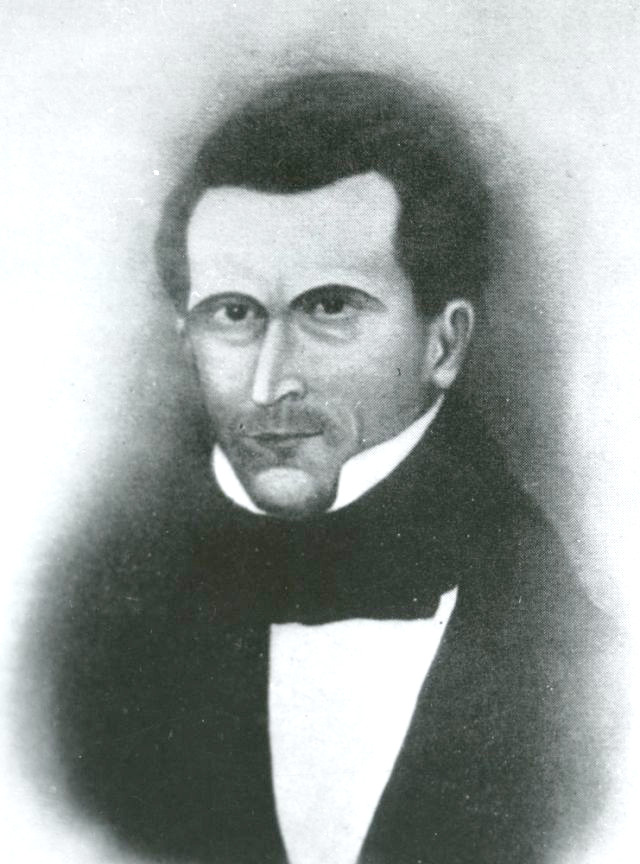George Miller
(1794-1856)

By Susan Easton Black
In 1838 George, a carpenter and mason by trade and a resident of Quincy, Illinois, first learned of the Restoration “from a recruiter seeking volunteers to fight in Missouri’s so-called Mormon War.”1 Although George was not interested in fighting the “Mormons” or hearing about the Restoration, when Latter-day Saints crossed the Mississippi River in the winter of 1839, seeking relief from the government-sanctioned extermination order in Missouri, he was one of the first to offer aid. He provided food and lodging for many of the exiled Saints.
George would probably not have listened to the Restoration message for a while if he had not seen the Prophet Joseph Smith:
A large man sitting in front [in a wagon] driving seemed to be familiar to me as if I had always known him, and suddenly the thought burst on my mind that it was none other than the prophet, Joseph Smith. Indeed, my whole frame was in a tremor with the occurrence of the thought.2
After listening to Joseph preach, George “had no remaining doubts left in regard to the truth of the prophet.”3 On August 10, 1839, he was baptized in the Mississippi River by John Taylor. Surprisingly, his entering baptismal waters led to the destruction of property and lawsuits. George wrote,
My cattle were shot on the prairies. … My fences [were] laid down, and the flocks and herds of the prairies turned on my grain fields. I was vexed by petty lawsuits. Men that I had never had dealings with would recover sums of money from me, by bringing into the justices court false witnesses, and those that owed me would prove payment.4
Rather than fight back, George left his holdings in Quincy and moved upriver to Nauvoo, Illinois. In that fledgling community, he was ordained a high priest by Joseph Smith, Hyrum Smith, and Newel Knight.
On January 19, 1841, the Prophet Joseph received a revelation informing him that “my servant George Miller is without guile; he may be trusted because of the integrity of his heart; and for the love which he has to my testimony I, the Lord, love him” (D&C 124:20). The office of bishop was conferred upon George. “The poor, the blind, the lame, the widow, and the fatherless all looked to me for their daily wants,” he said of being a bishop. “My days were filled with toil and care, and my nights … with sleepless anxiety in waiting on the suffering poor and the sick of the city.”5
In addition to being a bishop in Nauvoo, George was given the responsibility for procuring timber in the Wisconsin pineries for the construction of the Nauvoo House and the Nauvoo Temple. He was also asked to serve as a regent of the University of Nauvoo and a brigadier general in the Nauvoo Legion. George readily fulfilled these added responsibilities because of his love and admiration for the Prophet Joseph. He wrote, “I have known Joseph Smith intimately for near three & a half years. I unhesitatingly aver that … a more generous, liberal, honorable, high toned virtuous man, never existed on the footstool of the great Jehovah.”6
George did not have the same love and admiration for Brigham Young. Disagreements between the two Church leaders arose over settling the pioneering Saints among the Ponca Indians and which route to take to the Rockies. The disagreement became so heated that in March 1847 George withdrew from the Church. In a formal letter to Brigham Young, however, he reminded him of his service to the Church—
Although … in poverty and rags, I am not unwilling to undertake to do anything that this people persist in doing to build up this Kingdom. I have been as a beast of burden ever since I came into the church and I have never swerved in my actions, or feelings, to do with my might all things to push forward the cause of Zion, and am, and ever have been, willing to spend and be spent for the cause.7
On December 3, 1848, George was excommunicated. He joined the splinter group of Lyman Wight in Texas. Dissatisfied with the religious views espoused by Wight, George went to Michigan and joined the James Strang movement. In recognition for his missionary service to the Strangites, George was pronounced a prince, privy counselor, and general in Christ in the kingdom of God. George died in 1856 in Marengo, Illinois, at age sixty-two.
1. Heman Hale Smith, “George Miller, Journal of History,” 2, no. 2 (April 1909), 22.
2. Smith, “George Miller, Journal of History,” 23.
3. Smith, “George Miller, Journal of History,” 24–25.
4. Smith, “George Miller, Journal of History,” 26.
5. Smith, “George Miller, Journal of History,” 29.
6. Lyndon W. Cook, “‘A More Virtuous Man Never Existed on the Footstool of the Great Jehovah’: George Miller on Joseph Smith,” BYU Studies 19 (Spring 1979), 407.
7. Smith, “George Miller, Journal of History,” 30.
